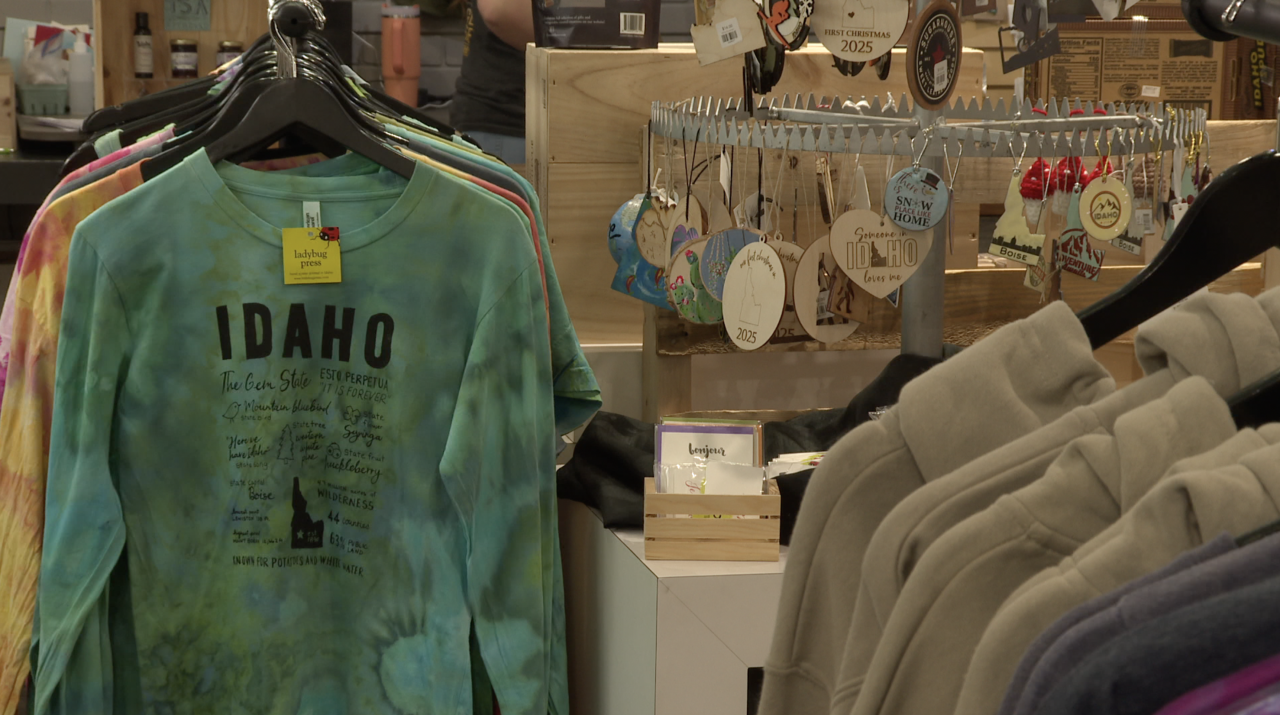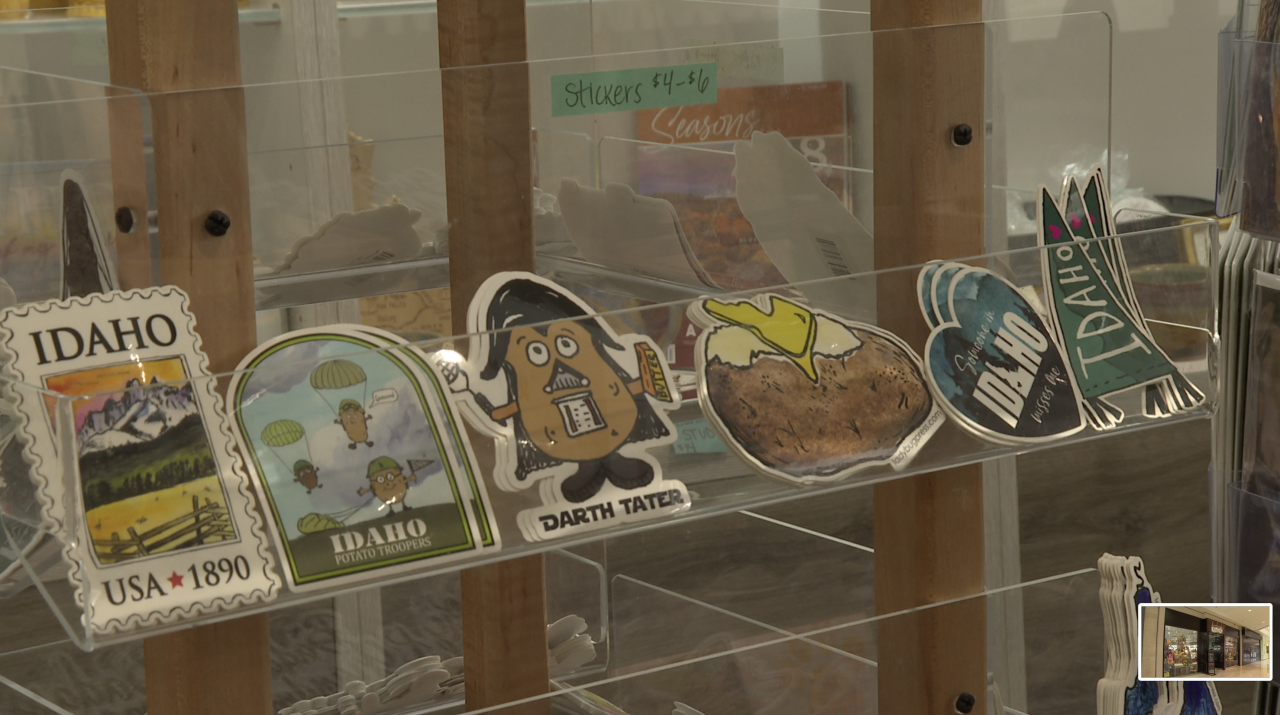Idaho
Made in Idaho: A behind-the-scenes look at the final days of onion harvest with J.C. Watson Co.

PARMA, Idaho — J.C. Watson Company — a fourth generation grower, packer, shipper in Parma and Wilder — is projected to pack around 200 million pounds of raw onions this season. We take you behind the scenes on the final days of onion harvest to show you how it all works.
- J.C. Watson ships millions of Idaho onions all over the United States and Canada.
- J.C. Watson received a $1.55 million grant from the USDA through the Resilient Food Systems Infrastructure Program — which aims to strengthen the food supply chain— to upgrade infrastructure for their rail shipping operation.
(Below is the transcript from the broadcast story)
Onion harvest is coming to a close, but the folks at J.C. Watson are still hard at work.
“The machines we’re using are Top Air onion loaders,” says Brad Watson, the President of J.C. Watson Company.
He tells me the Treasure Valley is the perfect place to grow onions because of the low humidity, long growing season, and ample irrigation.
These onion loaders pick up cured onions off the ground.
“They cut off the excess tops and then load them into the back of the semi trucks that will then take them to storage,” Watson said.
Those semi trucks then bring them to the packing shed where they are unloaded, inspected, weighed, and sorted before being packaged to be stored or sent to a variety of different buyers by truck or by rail.
“So this is kind of the whole purpose of this facility we’re in currently, right now we have two rail doors,” says Emily Watson-Libsack, VP of Sales and Marketing at J.C. Watson.
She tells me they just received a $1.55 million dollar grant from the USDA through the Resilient Food Systems Infrastructure program — which aims to strengthen the food supply chain.
They’ll use that money to improve infrastructure and upgrade equipment for their rail loading operation.
“The biggest improvements will be to the rail, which is kind of hard to see, but this rail track has been here for, I think, close to 100 years,” says Watson-Libsack.
She tells me they can fit 4.3 truckloads of onions in one rail car— a much more efficient option for getting onions from Idaho to buyers across the country.
“So we have different equipment that we submitted as part of the grant, so some of that is some racking systems, again it just makes it easier for loading our rail cars,” says Shelly Bateman, Director of Organizational Effectiveness at J.C. Watson.
She tells me along with a new high-tech racking system, refrigeration units will also help extend the season for local growers.
“This expansion and this grant is kind of allowing us to kind of prepare for the generations. And in order for us to do that in Idaho we have to expand our shipping, have high-tech equipment that we’re putting in, and be able to be competitive in the marketplace,” Watson-Libsack said.

Idaho
2 Idaho Lottery players will be millionaires in the new year – East Idaho News

BOISE – Two lucky Idaho Lottery players who participated in the 2025 Idaho $1,000,000 Raffle will begin the New Year as Idaho’s newest millionaires!
All 500,000 tickets in the Idaho Lottery’s traditional holiday game, the Idaho $1,000,000 Raffle, have been sold and the game has officially ended. The last ticket was sold Thursday, December 11.
This year’s game was one of the fastest-selling in the 19-year history of the Idaho $1,000,000 Raffle. After last year’s very successful game, the Idaho Lottery continued the game with two top prizes of $1,000,000. They also added a $100,000 prize and a $50,000 prize.
It is the 18th sellout and the 11th time the game has sold out before Christmas.
“We want to remind everyone this game features two, one-million-dollar top prizes. Last year, unfortunately, one of those $1,000,000 prizes was never claimed,” said Andrew Arulanandam, Idaho Lottery Director. “Keep your tickets in a safe place and remember to go online and check them after the drawing.”
The winning numbers will be announced at 5:59 p.m. Mountain Time on Monday, December 29.
“Idaho Raffle tickets are popular holiday gifts. So, this year, two lucky Idahoans could be instant millionaires because of their stocking stuffers!” added Arulanandam.
Players can check their tickets for winning numbers online, at all Idaho Lottery retail locations, on the Idaho Lottery winning numbers hotline at (208) 334-4656, or by using the Idaho Lottery Check-a-Ticket app for their iPhone or Android phone.
Besides the guaranteed top prizes of $1,000,000, there are over 21,500 additional prizes ranging from $15 up to $100,000. This year’s game also featured twenty, $1,000 prizes mid-game for players who purchased one of the 25,000th tickets. There were 15 daily, $1,000 winners during the first 15 days of sales. All players are encouraged to check their tickets for these promotion winners manually by visiting idaholottery.com.
All winning tickets of $1,000 and higher in this game must be claimed at Lottery offices in Boise. Players will have 180 days after the draw announcement on December 29, to claim their prizes.
This year’s Idaho $1,000,000 Raffle generated over $1.7 million for the Idaho Lottery’s beneficiaries, Idaho public schools and buildings.
During this gift giving season, the Idaho Lottery would like to remind everyone to gift Lottery tickets responsibly. You must be 18 years old to buy, sell, or redeem Lottery products in Idaho.
The following is a current list of $1,000 promotional winning tickets that remain unclaimed from this year’s Raffle:
- 035429
- 099040
- 122908
- 149710
- 158289
- 173160
- 192289
- 350000
- 425000
- 450000
- 475000
- 500000
=htmlentities(get_the_title())?>%0D%0A%0D%0A=get_permalink()?>%0D%0A%0D%0A=htmlentities(‘For more stories like this one, be sure to visit https://www.eastidahonews.com/ for all of the latest news, community events and more.’)?>&subject=Check%20out%20this%20story%20from%20EastIdahoNews” class=”fa-stack jDialog”>
Idaho
Idaho dance group preserves Mexican traditions through holiday Posada performances

NAMPA, Idaho — Families across Idaho celebrate traditions this season, and Ballet Folklorico Yareth de Idaho is bringing those stories to life with every step and every song, sharing the magic of a Posada with the community.
“Folklorico is very much our culture. It shows the whole story of Mexico,” said Marifer Avila, Ballet Folklorico Yareth de Idaho Instructor.
WATCH | What it takes to get students prepared + learn what a Posada is—
Idaho dance group preserves mexican posada traditions through folklorico
Walk into the Idaho Hispanic Community Center, and you’ll hear music bursting through the halls and see dancers from Ballet Folklorico Yareth de Idaho preparing for the most meaningful season in their culture.
“We as a group try our best to represent the most accurate when it comes to songs, steps, storytelling, vestuario; everything involved has a purpose, and from head to toe has to mean a purpose at all times,” Avila said.
Idaho News 6
With each step and every verse, they reveal what a posada truly is, full of life, color, and community. Their ballet folklorico performances don’t just celebrate the season; they help preserve rich traditions from regions across Mexico.
“It’s a big party traditionally in Mexico. It’s a Catholic holiday. It’s with a procession which is called birino posada— going to a door, getting rejected, going to another door, getting rejected again, and then finally having the host be like, ‘Fine, you can come in.’ And then there’s this party with piñatas and music and dancing and food and then prayers and a baby rocking,” Avila said.
For Avila, guiding her 30 students through every step and lyric isn’t just teaching — it’s ensuring each tradition is represented with heart and authenticity.
Idaho News 6

“They’ve learned that it’s a discipline, you know — wanting to go or not wanting to go, they’re here. You know, they’re learning that it’s a responsibility. It’s so beautiful that we can, as a group, represent that the best of our abilities on a stage where people can be entertained and understand our culture,” she said
Their holiday posada is sold out, and the group says plans are already in place to bring more dances to life in the new year.
Idaho News 6

For Canyon County happenings, news, and more— join our Facebook Group: 2C Neighborhood News – Nampa, Caldwell, Middleton
This story was initially reported by a journalist and has been, in part, converted to this platform with the assistance of AI. Our editorial team verifies all reporting on all platforms for fairness and accuracy.
Idaho
Handmade Idaho brings local artisans together under one roof at Boise Towne Square

BOISE, Idaho — What started as a holiday pop-up has transformed into a year-round celebration of Idaho creativity, bringing together the best local makers all in one convenient location.
Handmade Idaho, located at 350 N Milwaukee St Ste 1141 on the lower level of Boise Towne Square Mall, showcases goods from small artisans across the Gem State.
Handmade Idaho brings the best of local artisans to you.
Handmade Idaho brings local artisans together under one roof at Boise Towne Square
Owner Angela Stewart says the business grew out of a need to support local creators.
“We started as an organization to provide more opportunities for local artisans to sell their goods. So we had a holiday show for several years, and then COVID hit, and we had to cancel,” Stewart said.
After the pandemic forced cancellation of their holiday show, Stewart opened pop-up shops at The Village and later at Boise Towne Square Mall. The mall convinced her to return full-time, and she’s been operating there since 2022.
The permanent location allows customers to shop from local artisans seven days a week. Stewart accepts new makers through an online application at HandmadeIdaho.com.
“We still feature like local artisans from all over Idaho, but now, you know, people can shop them 7 days a week instead of just during the holidays,” Stewart said.
Inside the store, huckleberry items are particularly popular since it’s the state fruit.
Greenlee Clark / Idaho News 6
“We have everything Idaho huckleberry you can imagine, from soap to edible things, to tea towels,” Stewart said.
The store also features potato-themed products, including chips, soup mix, and bread mix, along with sweet treats, unique jewelry, apparel for all ages, hats, candles, glassware, and mugs. Some items are printed right in the shop, and apparel goes up to 3XL on many designs.
Greenlee Clark / Idaho News 6

The store’s most popular offering is custom and ready-to-go gift boxes available in three different sizes. Pre-made options include huckleberry-themed boxes, spud boxes, kitchen boxes, and spa boxes.
“You can pick all the goods you want, we’ll make it fit in a box, and we can ship it, or you can take it with you, but this is like a really ideal fun gift,” Stewart said.
For uncertain shoppers, Stewart offers guidance.
“If you’re buying a gift for somebody and you don’t know what they like, food is always a hit,” Stewart said.
About 90% of the inventory is available online, but the remaining 10% consists of one-of-a-kind items made by different artisans. The business also specializes in corporate gifting and helps customers with Secret Santa and white elephant gifts.
Greenlee Clark / Idaho News 6

“People come in here all the time. I don’t know what to get, and they just give us a budget, we’ll figure it out for you,” Stewart said.
Stewart, who also owns Ladybug Press and features those products in the store, emphasizes the community impact of supporting small businesses.
“When you shop our store, you’re helping your neighbors, you’re helping people in our actual community, and I think that, you know, that’s a really huge thing to be able to like vote with your dollars,” Stewart said.
Handmade Idaho is open seven days a week at 350 N Milwaukee St Ste 1141 on the lower level of Boise Towne Square Mall, with online shopping available at HandmadeIdaho.com.
-

 Alaska1 week ago
Alaska1 week agoHowling Mat-Su winds leave thousands without power
-

 Texas1 week ago
Texas1 week agoTexas Tech football vs BYU live updates, start time, TV channel for Big 12 title
-
Ohio1 week ago
Who do the Ohio State Buckeyes hire as the next offensive coordinator?
-

 Washington5 days ago
Washington5 days agoLIVE UPDATES: Mudslide, road closures across Western Washington
-

 Iowa6 days ago
Iowa6 days agoMatt Campbell reportedly bringing longtime Iowa State staffer to Penn State as 1st hire
-

 Miami, FL7 days ago
Miami, FL7 days agoUrban Meyer, Brady Quinn get in heated exchange during Alabama, Notre Dame, Miami CFP discussion
-

 Cleveland, OH6 days ago
Cleveland, OH6 days agoMan shot, killed at downtown Cleveland nightclub: EMS
-
World6 days ago
Chiefs’ offensive line woes deepen as Wanya Morris exits with knee injury against Texans






















